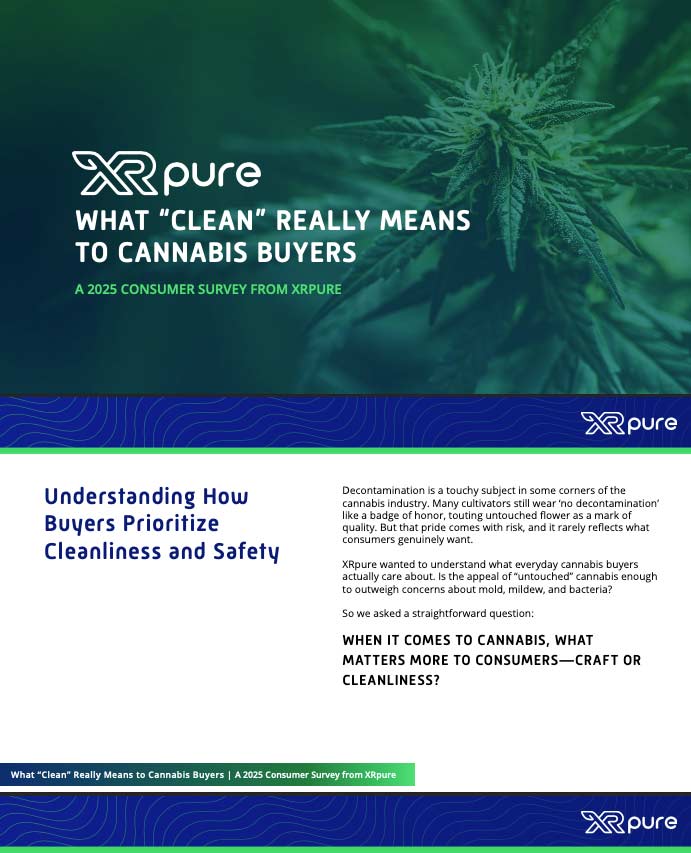After a recent high-profile case of cannabis contamination, it’s time we examine the dreaded Aspergillus mold.
Key Takeaways:
Aspergillosis refers to the contamination of cannabis plants and products by Aspergillus mold, which thrives in soil and can easily migrate to and affect cannabis under suitable conditions. This mold poses serious health risks and can lead to significant economic losses due to crop damage and product recalls.
Key signs of Aspergillosis include discoloration of leaves or buds, powdery residues, musty odors, wilting, and dense mold growths. Early detection through these signs can prevent widespread contamination.
Beyond visual inspection, employing technical methods such as PCR for genetic identification and chromatography for detecting mycotoxins is essential for accurately identifying and understanding the specific Aspergillus threats.
Effective Aspergillosis management involves maintaining low humidity and temperature, ensuring proper ventilation, using mold-resistant strains, and implementing rigorous sanitation practices. Education and continuous staff training on these practices are vital.
Despite best efforts, contamination can occur. XRpure provides advanced decontamination technologies that can help effectively manage and remediate aspergillosis outbreaks. These technologies are available through leasing, offering financial flexibility and opening access to the latest advancements.
In a striking blow that has caught the attention of both cannabis enthusiasts and safety regulators, California recently issued a mandatory recall for the cannabis flower branded by none other than celebrity boxer Mike Tyson.
Announced on April 9 by California’s Department of Cannabis Control (DCC), this recall was triggered by contamination from Aspergillus mold in Tyson’s Undisputed Cannabis Flower products. Serving as the 13th recall issued by the DCC in 2024—and the ninth specifically related to Aspergillus contamination—this incident sheds light on a persistent adversary in the cannabis industry: Aspergillosis.
In this blog, I’ll share insights into what Aspergillosis really is, help you identify signs of its presence in your crop, and discuss effective strategies to punch out this insidious enemy.
What is Aspergillosis?
Aspergillosis refers to the contamination of cannabis plants and products by Aspergillus, a common mold found in our environment. At XRpure, we’ve seen how this group of molds can impact the cannabis industry. They thrive in soil and decomposing plant material, but can easily migrate to and colonize cannabis plants under the right conditions. Among the several species of Aspergillus, the ones that concern us most in our field include:
- Aspergillus flavus: Known for producing aflatoxins, some of the most potent carcinogens.
- Aspergillus fumigatus: Commonly associated with respiratory infections in humans.
- Aspergillus niger: Easily recognizable by its black spores.
- Aspergillus terreus: Known for its resistance to certain antifungal treatments.
These molds pose a dual threat:
- Health Risks for Consumers: When inhaled, spores can lead to severe respiratory conditions, especially in individuals with weakened immune systems.
- Economic Impact on Businesses: Infestations can necessitate product recalls, damage brand reputation, and result in significant financial losses due to destroyed crops and lost sales.
Aspergillus spores are minuscule and airborne, capable of infecting cannabis at any stage of growth, processing, or storage. The spores can remain dormant until they find suitable conditions, such as the right temperature and humidity, to grow and produce mycotoxins, toxic compounds that are harmful when consumed or inhaled.
Spotting the Enemy: Signs and Symptoms in Your Crop
In my experience, having a green thumb isn’t enough with cannabis cultivation—you also need a keen eye, a nose for off-putting odors, and a real feel for your crop’s state of being. With those skills, you can stop Aspergillosis before it even begins to proliferate. Here are the key signs and symptoms I tell all our clients to watch out for:
- Discoloration: Initial signs often manifest as yellow or green patches on leaves or buds. These discolorations can later darken as the mold matures, turning into brown or black spots. Such changes usually indicate that the mold has begun to establish itself within the plant tissue.
- Powdery Residue: Aspergillus mold may appear as a powdery, white or gray residue on the surfaces of leaves, stems, and buds. This residue is composed of mold spores and mycelium, which can quickly proliferate under suitable environmental conditions.
- Musty Odor: A strong, musty odor often accompanies mold growth. This distinctive smell is a clear indication that mold, likely Aspergillosis, is developing within the crop. The scent might be detectable even if the mold itself isn’t visibly apparent, making it an essential symptom for growers to recognize.
- Leaf Wilting and Dieback: Infected plants may show signs of stress such as wilting or the dieback of leaves and stems. These symptoms can escalate as the mold consumes the nutrients and water routes within the plant.
- Dense, Sticky Mold Growth: In advanced stages, Aspergillosis can lead to dense mold growths that are sticky to the touch. This is particularly prevalent in humid conditions where the mold thrives most aggressively.
Recognizing these symptoms quickly enables more effective management strategies to be implemented before the contamination becomes widespread.
A Closer Look: Identifying Aspergillus Mold
Let’s get a tad more technical in examining our nemesis.
Morphological Characteristics

- Sporulation: Aspergillus species typically produce dense clusters of conidiophores, which are specialized structures responsible for spore production. The morphology of these conidiophores can be a key identifying feature. They generally have a columnar appearance with a rounded vesicle at the top, from which chains of spores (conidia) emerge.
- Conidia: The spores themselves are usually spherical and can vary in color from yellow to green or black, depending on the species. For instance, Aspergillus niger produces black conidia, whereas Aspergillus flavus and Aspergillus fumigatus produce green spores.
- Hyphae: Aspergillus molds grow as branching filaments called hyphae, which are segmented by internal dividers known as septa. Initially, these hyphae are almost clear or very light in color but may darken as they mature. This change in color can help in identifying the age and type of the mold growth.
Genetic Identification
While morphological examination is useful, genetic testing provides the most definitive identification of Aspergillus species. Techniques such as polymerase chain reaction (PCR) and sequencing of specific genomic regions (like the internal transcribed spacer or ITS region) are commonly used.
Secondary Metabolites
Many Aspergillus species produce distinct secondary metabolites, including mycotoxins, which can be harmful to humans. Chromatographic techniques such as gas chromatography-mass spectrometry (GC-MS) or high-performance liquid chromatography (HPLC) are employed to detect and quantify these compounds.
Fortifying Your Defense: Prevention Strategies
I’m a firm believer that controlling Aspergillosis in cannabis cultivation demands a proactive approach. Preventing its introduction and proliferation begins with understanding the environmental factors that encourage its growth and implementing robust strategies to mitigate these conditions.
Here are key prevention strategies I recommend to help safeguard your cannabis crops:
Environmental Control
- Humidity and Temperature Management: Aspergillus thrives in warm, moist environments. Maintaining relative humidity below 50 percent and keeping temperatures in check (ideally below 25°C or 77°F) can significantly reduce the risk of mold growth. Use dehumidifiers and air conditioning systems where necessary.
- Adequate Ventilation: Good air circulation prevents moisture accumulation and dispersing mold spores. The cultivation area must be well-ventilated with fans or ventilation systems that facilitate constant air movement and exchange.
Cultivation Practices
- Sanitary Cultivation Practices: Start with clean, high-quality seeds or clones to avoid introducing mold from the beginning. Regularly disinfect tools, containers, and surfaces to prevent the transfer of mold spores across plants.
- Crop Rotation and Spacing: Avoid planting cannabis too densely. Adequate spacing allows for better air circulation around each plant, reducing moisture retention and limiting mold growth. Implementing crop rotation can also help prevent the buildup of soil pathogens over time.
Material and Facility Management
- Use of Mold-Resistant Strains: Some cannabis strains are more resistant to mold than others. Choosing these strains can inherently reduce the risk of Aspergillosis.
- Regular Inspection and Maintenance of Facilities: Periodic checks for leaks, condensation, or other sources of excess moisture can prevent the development of damp conditions conducive to mold growth. Repair and address these issues promptly.
Biological and Chemical Control
- Biological Controls: Introducing beneficial microbes that compete with or inhibit the growth of mold can be an effective organic approach to preventing Aspergillosis.
- Chemical Fungicides: While less favored due to potential residue, fungicides can be used in some regions under strict regulations. Any chemical utilized should be approved for use in cannabis cultivation and applied according to label instructions.
Education and Training
- Staff Training: Educating all staff involved in the cultivation, processing, and handling of cannabis about the signs of mold and proper hygiene practices can significantly enhance your overall prevention strategy. Regular training sessions should cover how to handle outbreaks and the importance of personal hygiene to prevent contamination.
When Prevention Fails: Effective Decontamination Techniques
Even with the most rigorous anti-Aspergillosis strategies in place, sometimes that dreaded mold finds its way into our crops. It’s frustrating, I know. But don’t worry. At XRpure, we’ve seen it all before and we’ve crafted a comprehensive approach to tackle mold contamination head-on.
When it comes to fighting mold, the first thing I always recommend is getting right down to the source—removing any contaminated plant material to keep it from spreading. You’ve got to be meticulous here; carefully disposing of infected plants is key to nipping the issue in the bud.
When it comes to getting things clean—heat and UV treatment can be real lifesavers. These methods zap those pesky mold spores right off your surfaces and out of the air. And let’s talk chemicals for a sec—sure, certain fungicides and biocides can wipe out mold spores, but you’ve got to handle these with care. We want to wipe out the mold without leaving anything harmful behind that could affect the safety and healthiness of your products.
Now, onto something I’m really passionate about—our XRpure equipment. When you lease from us, you’re getting access to some seriously advanced tech that keeps your operation running smoothly, even when mold tries to throw a wrench in the works. Our systems are perfect for handling big jobs fast, which means less downtime and more productivity for you.
Leasing XRpure Equipment
- Risk Management: Our gear drastically cuts down the risks tied to mold. It’s about protecting your product’s quality as much as your bottom line.
- Cost Efficiency: Leasing gets you our best technology without the hefty upfront cost. Plus, these costs can often be deducted under tax codes, easing your tax burden. Our leasing program also includes all repair and service, which keeps you running clean with no additional costs.
- Keeping Your Edge: In this industry, a mold-free product is a must for staying ahead. Our tech keeps things clean and boosts your brand’s reputation.
- Always Up-to-Date: With our leasing options, you’re always equipped with the latest and greatest to face any new challenges head-on.
- Support and Expertise: We’re here to train you and support you, making sure you get the most out of our technology.
Wrapping Up: A Call to Vigilance
The massive recall of Tyson’s cannabis flower, triggered by Aspergillus contamination, serves as a potent reminder of the challenges we face in this industry. This high-profile case underlines the critical importance of maintaining vigilance and adopting best practices in cannabis cultivation and safety.
Here at XRpure, we’re dedicated not just to reacting to such incidents, but to preventing them. By fostering a culture of proactive care and continuous education within the cannabis community, we can guard against similar issues.
I urge every one of you in the cannabis industry to stay informed, stay equipped, and most importantly, stay ahead of the curve. Equip your operations with the necessary tools and knowledge to prevent mold before it takes hold.
Let’s learn from each incident and move forward with a renewed commitment to excellence and safety. Together, we can avoid getting knocked out by Aspergillus contamination.
Connect with XRpure! We’ll answer your contamination questions!
